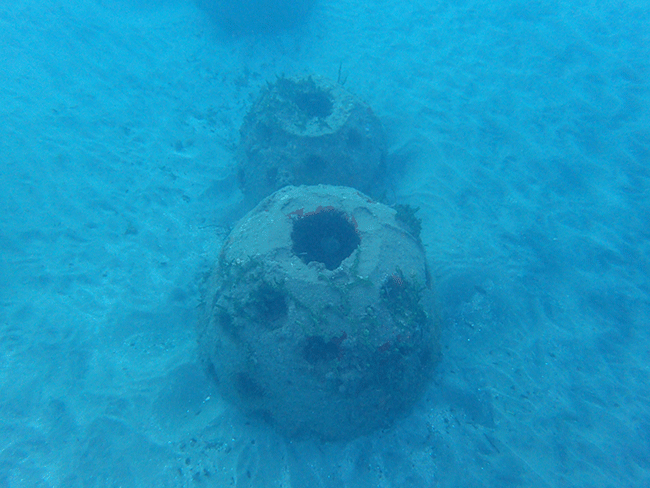Programs Blog
Rewilding through Offshore Wind Artificial Reefs

Rewilding is an environmental management strategy that aims to restore degraded natural habitats. Instead of continual management, this approach uses targeted interventions to allow ecosystems to recover their natural processes to a point that they no longer need human input to maintain a healthy state. Many forms of rewilding have been developed on land — ranging from nonintervention policies which protect from any human activities such as hunting, forestry, or agriculture to targeted reintroduction of key species. Both strategies have been implemented in the Swiss National Park, and it has resulted in the reappearance of large predators, which is critical for the long-term health of ecosystems because they help to keep herbivore populations at a healthy range (Perino et al, 2021).
The oceans are home to a variety of ecosystems that provide essential ecosystem services and contain a great deal of biodiversity. Consequently, marine habitats have been the subject of many rewilding efforts. One exciting strategy used to rewild the oceans is the introduction of artificial reefs — structures that provide a habitat for marine species in an area that has been previously destroyed, has low marine activity, or has been negatively affected by climate change events. Artificial reefs provide habitat for important species and help to restore the species abundance and diversity of degraded reefs nearby through a process called dispersal, in which larval organisms travel and colonize new habitats. This interconnectivity through dispersal also increases the habitats’ resilience in the face of disturbances.
Offshore Wind farms present an exciting new opportunity to create reefs for marine habitats. In this form of oceanic rewilding, the turbine structures in the water serve as artificial reefs that become areas of high biological activity. Not only will this increase ecosystem productivity, but it will also help maintain the resilience of nearby ecosystems which currently face climate change related disturbances such as increasing sea surface temperature, sea-level rise, or more intense storms. Studies have shown that creating these structures encourages the reappearance of fish, crustaceans, and shellfish to areas of high disturbance. For example, in Belgium, Denmark, and China, the introduction of offshore wind farms has caused an increase in abundance of marine life that was previously not present. The increase in new species (especially crab species) has led to an increase in other marine organisms like fish and mussels due to the creation of a sanctuary area (Langhamer 2012).
Offshore wind farms offer two advantages; they are a source of renewable energy and they can create beneficial artificial reefs. Finding feasible ways to implement renewable energy is an absolute necessity as our global climate continues to change and the need to mitigate human impacts continues to drastically increase. Due to strong and consistent winds on the oceans, offshore wind as a very favorable way to create a source of renewable energy that is more powerful than wind farms on land. Artificial reefs often come as an unintentional but helpful byproduct of the wind turbine itself. It is also possible to turn offshore wind farms into productive aquacultural farms. In these cases, not only does it have benefits for the marine ecosystem, but it can be a way to provide food and a source of income for the coastal areas where these wind farms exist (Buck et al, 2008). Due to their ability to simultaneously combat greenhouse gas emissions, create artificial habitats, and offer more economic advantages to local coastal communities, offshore wind artificial reefs present an exciting opportunity for US policymakers to make positive change.
– Kayla, Izzy, Leanna
Recent Posts from the Ships
- Ocean Classroom 2024-A collaborative high school program with Proctor Academy
- Collaborations and Long-term Commitments: SEA’s Caribbean Reef Program Sets a Course for Coastal Programs that Compliment Shipboard Experiences.
- Sea Education Association students prepare for life underway using state of the art nautical simulation from Wartsila Corporation.
- SEA Writer 2022, Magazines From the Summer SEA Quest Students
- Technology@SEA: Upgrades Allow Insight into Ocean Depths
Programs
- Gap Year
- Ocean Exploration
- High School
- Science at SEA
- SEA Expedition
- SEAScape
- Pre-College
- Proctor Ocean Classroom
- Protecting the Phoenix Islands
- SPICE
- Stanford@SEA
- Undergraduate
- Climate and Society
- Climate Change and Coastal Resilience
- Coral Reef Conservation
- Marine Biodiversity and Conservation
- MBL
- Ocean Exploration: Plastics
- Ocean Policy: Marine Protected Areas
- Oceans and Climate
- Pacific Reef Expedition
- The Global Ocean: Hawai'i
- The Global Ocean: New Zealand